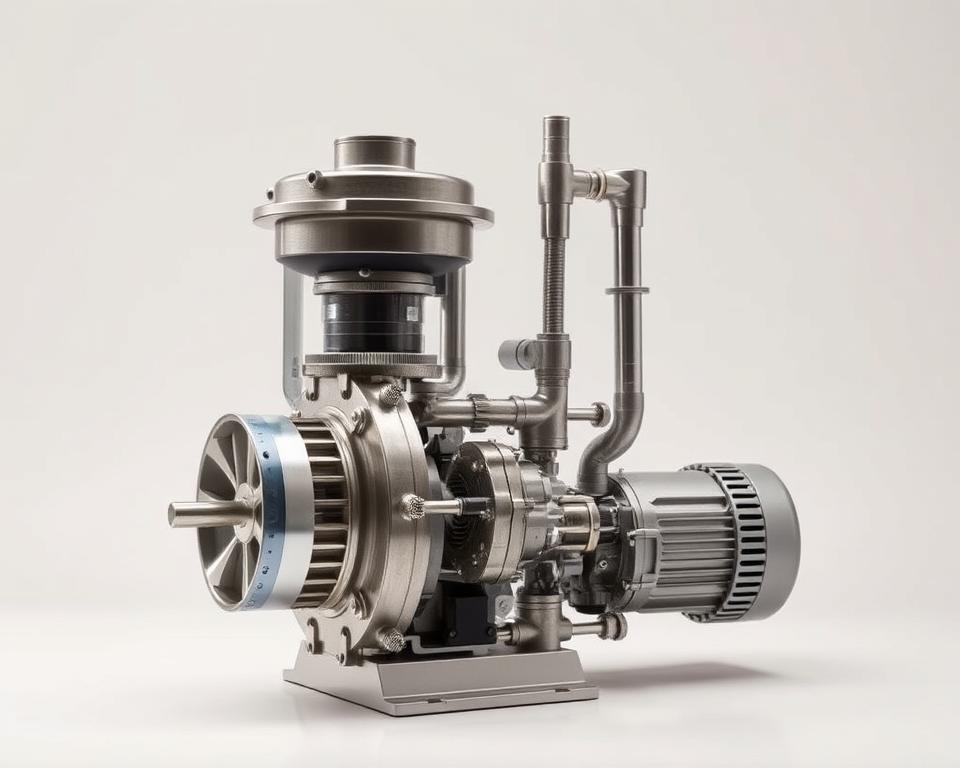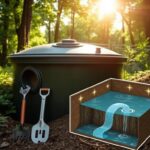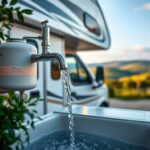Understanding and Maintaining Your RV Black Water Tank Pump
Have you ever thought about how the RV black water tank pump affects your RV trips? A crucial aspect of your RV’s hygiene system is the black water tank pump. Proper maintenance is crucial for seamless travels. This guide offers vital information on managing your RV waste water pump. Recognizing its significance will lead to bettering its operation and making your RV adventures more fun.
Core Findings
- The RV black water tank pump plays a vital role in efficient waste disposal.
- To ensure your RV waste water pump has a longer lifespan, regular maintenance is necessary.
- Having knowledge of the system’s components assists in problem-solving.
- Safe dumping practices are essential for both hygiene and the environment.
- Winter preparation of your RV black water tank system helps avoid expensive fixes.
- Maintaining the cleanliness of your RV sanitation pump will help avoid clogs and unpleasant smells.
Grasping RV Water Tank Basics
A lot of RV owners might not completely understand why different water tanks are important for easy camping with RV waste water pump. A key aspect is knowing the functions of the RV fresh water, gray water, and black water tanks. Each plays a unique role and needs proper care.
The purpose of the RV fresh water tank is to store water that is safe to drink. You use it for drinking, preparing food, and personal cleanliness. The cleanliness of this tank and the safety of the water are extremely important. Fresh water is crucial for hydration and health during travels.
On the other hand, the RV gray water tank collects wastewater from sinks and showers. This tank can quickly become full, requiring frequent checks and draining. Correct management of the gray water tank is vital for a clean RV interior.
This RV black water tank is crucial as it contains toilet waste. It demands constant vigilance to avoid smells and buildup. Applying the proper tank chemicals will benefit the tank’s condition and your RVing experience. Knowing how to care for each tank makes RV trips more enjoyable.
The Function of an RV Black Water Tank Pump
For the sanitation systems of recreational vehicles, the RV black water tank pump is essential. Waste is transported by this pump to designated places for disposal. To maintain it correctly and avoid expensive problems, you need to know how it works.
Owners of RVs have a selection of pump types to choose from, including the sewer pump. The macerator pump is a favorite because it grinds waste, making disposal faster. This feature is very helpful at dump stations that are busy.
The key to good waste management in an RV is a quality black tank pump. This pump contributes to a clean and comfortable environment inside the RV. If you regularly inspect your pump and understand its operation, you can improve your time in your RV.
Identifying the Components of the Black Water Tank System
The RV black water tank system must be understood for proper waste management. For the system to function correctly, it relies on many essential components working together. Waste from the RV toilet is stored in the black water tank, the system’s most critical component. Made of sturdy materials, it’s designed to endure various conditions.

Transferring waste to a specific dump station, the system’s pump is very important. RV owners cannot do without it. Another key component is sewer hoses, which offer a flexible connection linking the tank to the dump station. Made to prevent leaks and keep odors contained, these hoses ensure a clean way to dispose of waste.
For the attachment of sewer hoses, which enables effective waste transfer, connection ports are essential. Controlling the flow of waste is the crucial role of termination valves. They prevent backflow and spills during disposal, preserving sanitation.
By becoming familiar with these vital components, RV owners can maintain their sanitation system effectively. Knowing this is crucial for fixing problems while traveling or using the RV, which improves the whole RV experience.
Best Practices for Using Your RV Black Water Tank Pump
Using the RV sanitation pump correctly will greatly improve your RV life. Operating the black tank properly is crucial for ensuring the system works without issues. A crucial step is to make sure you flush the tank well after each use. It helps prevent solid waste from accumulating, potentially causing blockages and other problems.
Checking your RV sanitation pump regularly makes sure it’s working the way it should. This preventative step helps you steer clear of any unwanted situations during your travels. It is also essential to use toilet paper made specifically for RVs. This kind of paper is made to break down fast, which lowers the chance of clogs.
It’s also crucial to keep the termination valves closed, except when you are emptying the tank. This will help keep the smells away. Also, adding tank deodorants and cleaners will help the system smell nice and stay clean. Adhering to these guidelines enhances your experience with the RV black water tank.
| How to Properly Use Your Black Tank | Benefits |
|---|---|
| Ensure Ample Water for Flushing | Prevents solid waste clogs |
| Regular Pump Operation Checks | Helps ensure it’s working as it should |
| Use RV-Specific Toilet Paper | Decreases the likelihood of clogs |
| Always Keep the Termination Valves Closed | Helps keep odors down |
| The Use of Tank Deodorants and Cleaning Agents | Keeps the system smelling fresh and clean |
Must-Know Maintenance Tips for the Black Water Tank Pump
It’s vital to maintain your RV’s black water tank pump regularly so it lasts longer and works efficiently. Part of this is using the appropriate chemical treatments that are specifically formulated for these tanks. They work well to dissolve waste and prevent odors from forming.
It’s also vital to make sure plenty of water is used when flushing the toilet. Doing so helps waste move smoothly to the tank, minimizing buildup risk. In addition, it’s important to regularly deep clean the tank and all the parts that go with it. Use the recommended tools for this important task.
Keep an eye on the tank levels at all times to prevent problems. Don’t wait to fix any leaks or overflows that you notice. Make sure to empty the tank regularly to prevent solid waste accumulation. To help ensure you have a smooth RV experience, create a maintenance schedule.
| Maintenance Item | Timing | What to Do |
|---|---|---|
| Monitor levels | Every trip | Ensure the tank is not overfilled to prevent leaks. |
| Treat with chemicals | Every time you empty it | Use treatments to help break down waste well. |
| Do a system flush | Every month | Use a cleaning solution to maintain tank cleanliness. |
| Look over the pump | Before any long travel | Examine the pump for any signs of wear or damage to prevent it from failing on the road. |
| Tank emptying | When necessary | When the tank gets full, make sure to empty it, ideally at the proper disposal sites. |
Following these key maintenance practices will ensure your black water tank pump works well. This will improve your RV trips significantly.
Troubleshooting Common Problems with Your Black Water Tank Pump
Dealing with problems with your black tank pump might seem difficult. A lot of RV owners experience different problems with their RV black tanks, like clogs, leaks, or smells that won’t go away. If you know how to deal with these problems early on, you can save time and money on repairs.
Start by inspecting the hoses connected to the black tank pump. Often, blockages form in these hoses, making the pump less effective. Take the hoses off and see if there’s any buildup or dirt inside. If you find any blockages, make sure to clean the hoses completely before putting them back on.
The next step is to evaluate the seals around the pump and the tank. Leaks can happen if the seals are damaged, and you might not realize it until there’s been a lot of damage. To prevent more issues, replace any seals that are damaged or not working correctly immediately.
For persistent odors, utilizing enzyme treatments can be beneficial. These treatments help to dissolve waste and get rid of bad smells. Make sure to follow the manufacturer’s instructions for optimal results.
Here is a quick reference table summarizing common issues and their solutions:
| Concern | Likely Cause | What to Do |
|---|---|---|
| Blockages | Accumulation of material in the hoses or tank | Check and clean hoses |
| Loss of liquid | Faulty seals | Inspect and replace seals |
| Bad smells | Too much waste in the tank | Treat with enzymes |
| Pump is not operating | Electrical issues | Inspect the connections and battery |
Spotting the initial signs of trouble can prevent minor issues from escalating into serious RV black tank problems. By performing regular maintenance and being vigilant, you can extend the life of your black tank pump, which will enhance your RV experience.
How to Clean Your RV Black Water Tank Pump
Maintaining a clean RV black water tank is crucial for both hygiene and the proper operation of its plumbing system. Make it a goal to rinse with fresh water after each use to minimize odors and ensure smooth operation. This practice helps in reducing the buildup of waste and keeps the tank in good shape.
For a deeper clean, use cleaning solutions made for black water systems. These agents effectively dissolve waste and fight against odors. Fill up the tank with water and the cleaning solution, and then let it sit for a while. Having a built-in flush system in your RV simplifies the cleaning process.
Driving with sharp turns or using sloshing techniques can help to stir up the contents of the tank. This helps loosen residue on the tank walls. Cleaning in this way helps the sensors be more accurate, which can help you avoid sewage problems.
Safe Dumping Practices at Dump Stations
Knowing the proper way to behave at RV dump stations is important so that everyone can use them comfortably. Upon reaching a station, make sure your RV is positioned correctly. Then, get your gear ready for dumping.
To make sure the process goes smoothly, follow these steps closely:
- Check that your sewer hose is tightly connected to the station’s outlet.
- The first step is to open the black water valve so the sewage can flow out.
- After the black tank empties, close its valve. Then, open the gray water valve to clean the hose with the less dirty water.
- After finishing, carefully disconnect your hose to ensure no spills occur.
- You should always clean your hoses with drinking water and put them away right away.
It’s also vital that you adhere to the local laws regarding waste disposal. Many places have rules you must obey to protect the environment. Failure to follow these regulations can lead to fines or other problems.
Respectful behavior at RV dump stations contributes to a better experience for all users. If you keep the area clean and follow the rules, you’re showing that you care about the community. These kinds of actions help to build a culture of responsibility among RV lovers and encourage camping habits that are environmentally friendly.
Winterizing Your RV Black Water Tank System
To protect your black water system from freezing, it’s important to winterize your RV tanks. To avoid damage from water freezing within the system, it’s important to prepare correctly. To make sure your RV black tank is effectively cared for in the winter, you need to follow specific steps.
- Begin the process by fully draining the black water tank with the correct pump and connections.
- The next step is to bypass the water heater to stop water from getting in and collecting in it.
- Use RV-specific antifreeze, as regular antifreeze can be toxic and harmful to the environment. Pour the antifreeze into the system according to the product instructions.
- Leave all faucets and drains open to allow any remaining water to escape and for the antifreeze to circulate properly.
- Finally, ensure that all access panels are properly sealed and secured to prevent water from entering during the winter.
By taking these winterization steps, RV owners protect their black water tank systems from harsh winter impacts. This proactive approach helps to avoid expensive repairs or maintenance when the seasons change.
Conclusion
A big part of being a successful RV owner is maintaining your RV black water tank efficiently. If you understand how to use the black water tank pump well and follow the maintenance tips in this guide, your travels will be more enjoyable. By taking good care of your equipment, you’ll extend its life and simplify the process of managing waste in your RV. This makes travel less daunting.
To handle problems with your RV’s black water system effectively, you need to know about it. Following good maintenance, troubleshooting, and cleaning procedures will help prevent unexpected malfunctions. This lets you enjoy worry-free road trips. Getting help from trusted services like All in Sanitation can support your maintenance efforts. They provide essential products and support for top-notch care.
To be a good RV owner, you need to be attentive and take proper care of all parts of your vehicle, including the black water tank. Now that you know this, you’re all set to explore freely. You’ve made all the correct decisions to guarantee a wonderful journey for yourself and those with you.

